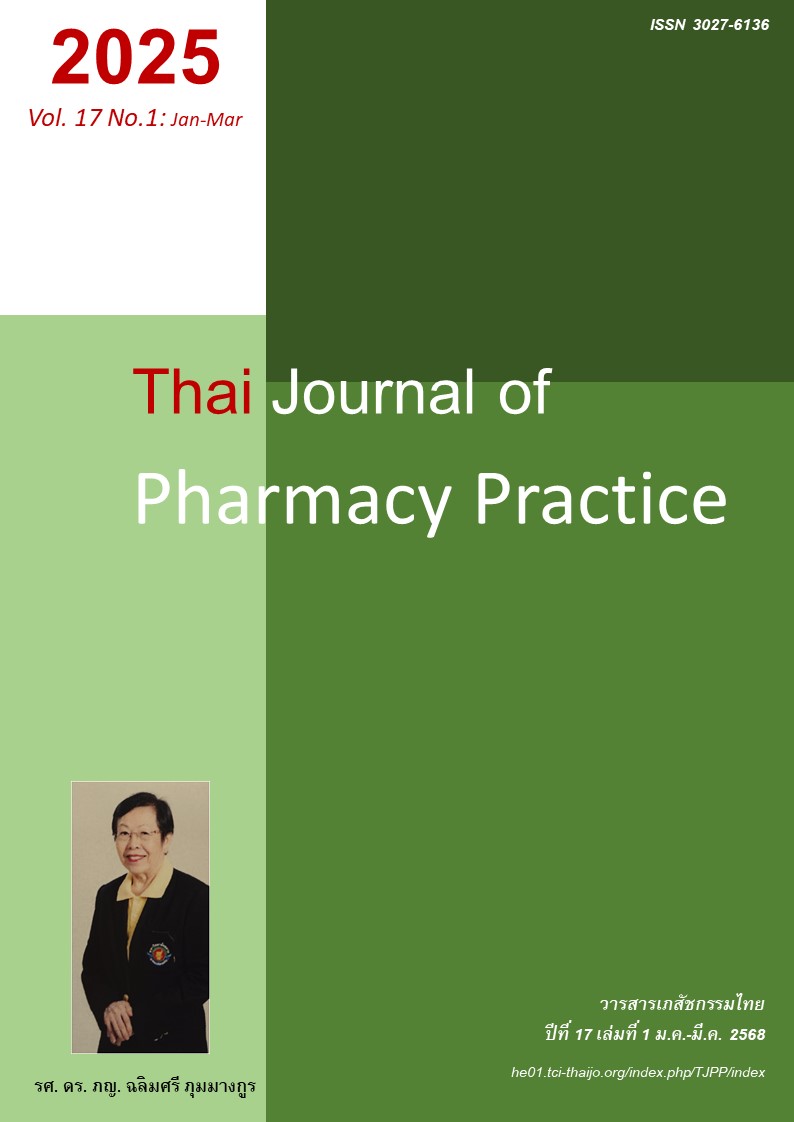การใช้กฎความสัมพันธ์เพื่อศึกษารูปแบบการสั่งใช้ยาลดระดับน้ำตาลในเลือดในผู้ป่วยเบาหวาน ชนิดที่ 2 ที่มีโรคร่วมจำแนกตามการควบคุมระดับน้ำตาลในเลือดในโรงพยาบาลตำรวจ
Main Article Content
บทคัดย่อ
วัตถุประสงค์: เพื่อให้ทราบรูปแบบการสั่งใช้ยาลดระดับน้ำตาลในเลือดในผู้ป่วยเบาหวานชนิดที่ 2 ที่มีโรคร่วมจำแนกตามการควบคุมระดับน้ำตาลในเลือดในโรงพยาบาลตำรวจด้วยกฎความสัมพันธ์ วิธีการ: การศึกษาเชิงพรรณาครั้งนี้ เก็บข้อมูลย้อนหลังจากเวชระเบียนอิเล็กทรอนิกส์ของผู้ป่วยเบาหวานชนิดที่ 2 ที่รับยาลดระดับน้ำตาลในเลือดจากห้องจ่ายยาผู้ป่วยนอกระหว่างวันที่ 1 มกราคม พ.ศ.2563 ถึง 31 ธันวาคม พ.ศ.2565 และมีผลตรวจน้ำตาลในเลือด การวิเคราะห์รูปแบบการสั่งใช้ยาใช้กฎความสัมพันธ์ด้วยอัลกอริทึมอพริโอริในโปรแกรม RStudio ผลการวิจัย: การศึกษาพบใบสั่งยา 51,502 ใบที่เข้าเกณฑ์การศึกษา โรคร่วมที่พบมาก ได้แก่ ความผิดปกติของไขมันในเลือด ความดันโลหิตสูง ไตวายเรื้อรัง เป็นต้น ส่วนมากรูปแบบการสั่งใช้ยาลดระดับน้ำตาลในเลือดของผู้ป่วยที่ไม่มี/มีโรคร่วมคล้ายคลึงกัน คือ มีการใช้ยา metformin มากที่สุด และใช้ร่วมกับยา glipizide และ/หรือ pioglitazone และยา metformin ร่วมกับยากลุ่ม DPP-4 inhibitors (dipeptidyl peptidase-4 inhibitors) หรือ SGLT-2 inhibitors (sodium-glucose co-transporter-2 inhibitors) ยกเว้นผู้ป่วยโรคร่วมไตวายเรื้อรังที่ใช้ยาฉีดอินซูลินเป็นส่วนมาก และผู้ป่วยโรคร่วมโรคหัวใจขาดเลือดเรื้อรังใช้ยา metformin ร่วมกับยากลุ่ม SGLT-2 inhibitors มากกว่าผู้ป่วยกลุ่มอื่น จากรูปแบบการสั่งใช้ยาผู้ป่วยที่ไม่มี/มีโรคร่วม ในผู้ป่วยกลุ่มที่สามารถควบคุมระดับน้ำตาลในเลือดได้ตามเป้าหมาย และผู้ป่วยกลุ่มที่ไม่สามารถควบคุมระดับน้ำตาลในเลือดให้เป็นไปตามเป้าหมาย ส่วนใหญ่มีรูปแบบการสั่งใช้ยาคล้ายคลึงกัน แต่มีค่าสนับสนุนการสั่งใช้ยาที่แตกต่างกันอย่างมีนัยสำคัญทางสถิติ (P < 0.05) ยกเว้นผู้ป่วยที่มีโรคร่วมไตวายเรื้อรัง ผู้ป่วยทั้งสองกลุ่มมีการสั่งใช้ยาแตกต่างกัน และส่วนใหญ่การสั่งใช้ยามีค่าสนับสนุนไม่แตกต่างกัน สรุป: กฎความสัมพันธ์ด้วยอัลกอริทึมอพริโอริ ช่วยค้นหารูปแบบการสั่งใช้ยาลดระดับน้ำตาลในเลือดจากใบสั่งยาจำนวนมากได้อย่างรวดเร็ว การมีโรคร่วมและความสามารถในการควบคุมระดับน้ำตาลในเลือดมีความเกี่ยวข้องกับการสั่งใช้ยาสำหรับผู้ป่วย ข้อมูลที่ได้สามารถนำมาปรับการดูแลและให้คำแนะนำแก่ผู้ป่วยต่อไป
Article Details

อนุญาตภายใต้เงื่อนไข Creative Commons Attribution-NonCommercial-NoDerivatives 4.0 International License.
ผลการวิจัยและความคิดเห็นที่ปรากฏในบทความถือเป็นความคิดเห็นและอยู่ในความรับผิดชอบของผู้นิพนธ์ มิใช่ความเห็นหรือความรับผิดชอบของกองบรรณาธิการ หรือคณะเภสัชศาสตร์ มหาวิทยาลัยสงขลานครินทร์ ทั้งนี้ไม่รวมความผิดพลาดอันเกิดจากการพิมพ์ บทความที่ได้รับการเผยแพร่โดยวารสารเภสัชกรรมไทยถือเป็นสิทธิ์ของวารสารฯ
เอกสารอ้างอิง
World Health Organization: Diabetes [online].2021 [cited Oct 8, 2021]. Available from: www.who.int/ news-room/fact-sheets/detail/diabetes.
International Diabetes Federation. IDF diabetes atlas 10th ed. Brussels, Belgium: International Diabetes Federation; 2021.
Diabetes Association of Thailand: Diabetes situation in the western Pacific region in 2017: IDF diabetes atlas [online]. 2017 [cited Oct 8, 2021]. Available from: www.dmthai.org/new/index.php/sara-khwam-ru/the-chart/the-chart-1/2018-02-08-14-52-46.
Diabetes Association of Thailand: Survey of Thai people's health by physical examination of the Public health systems research institute comparison between 2009 and 2014: the Public health systems research institute [online]. 2017 [cited Oct 20, 2021]. Available from: www.dmthai.org/new/index.php/sara-khwam-ru/the-chart/the-chart-1/2018-02-09-00-17-33
American Diabetes Association. Standards of medi- cal care in diabetes -2022 abridged for primary care providers. Clin diabetes 2022; 40: 10-38.
Luckanajantachote P, Pongmesa T, Sealim W, Cha roenworachai N, Piensaknusorn N, Kanjanawiwin A. Antihyperglycemic drug use pattern and the toward clinical exellence network's diabetes Indicators (TC EN DM) in patients with type 2 diabetes mellitus at Samutsakhon hospital. Veridain e-Journal, Sciene and Technology Silpakorn university. 2017; 4: 1-18.
Lee Y, Kim H, Jeong H, Noh Y. Patterns of multimor- bidity in adults: an association rules analysis using the korea health panel. Int J Environ Res Public Health 2020; 17: 2618.
Indu R, Adhikari A, Maisnam I, Basak P, Sur TK, Das AK. Polypharmacy and comorbidity status in the treatment of type 2 diabetic patients attending a tertiary care hospital: An observational and question- naire-based study. Perspect Clin Res 2018; 9: 139-44.
Held F, Le Couteur DG, Blyth FM, Hirani V, Nagana than V, Waite LM, et al. Polypharmacy in older adults: association rule and frequent-set analysis to evaluate concomitant medication use. Pharmacol Res 2017; 116: 39-44.
Rhee JJ, Han J, Montez-Rath ME, Kim SH, Cullen MR, Stafford RS, et al. Antidiabetic medication use in patients with type 2 diabetes and chronic kidney disease. J Diabetes Complications 2019; 33: 107423
Sukontavaree C. Using association rule to study pattern of medicine use in Thai adult depressed patients based on medical adherence [master thesis]. Nakonprathom: Silpakorn University; 2015.
Pattanaprateep O, McEvoy M, Attia J, A T. Evalua- tion of rational nonsteroidal anti-inflammatory drugs and gastro-protective agents use; association rule data mining using outpatient prescription patterns. BMC Med Inform Decis Mak. 2017; 17: 96.
Diabetes Association of Thailand and the Endocrine Society of Thailand. Clinical practice guideline for diabetes 2017. Bangkok: Srimueng Printing; 2017.
Buathong W. Chapter 4 Association rule [online]. 2014 [cited Oct 1, 2021]. Available from: wipawanblo g.files.wordpress.com/2014/06/chapter-4-associa tion-rule.pdf.
Agrawal R, Imielinski T, Swami A. Mining associa- tion rules between sets of items in large databases. Acm Sigmod Record 1993; 22: 207-16.
American Diabetes Association. Diabetes care 2022. Pharmacologic approaches to glycemic treatment: standards of medical care in diabetes. 2022: 45 (Suppl. 1); S125–43.
Thanakitcharu P, Bunnak S, Pichaiwong W. Chronic kidney disease: CKD. In: Makornsarn CH, editor. Thailand medical services profile 2011-2014 Nonthaburi: Department of Medical Services; 2014.
Ma H, Ding J, Liu M, Liu Y. Connections between various disorders: combination pattern mining using apriori algorithm based on diagnosis information from electronic medical records. Biomed Res Int 2022: 2199317
Shin AM, Lee IH, Lee GH, Park HJ, Park HS, Yoon KI, et al. Diagnostic analysis of patients with essential hypertension using association rule mining. Health Inform Res. 2010; 16: 77-81.
Agarwal AA, Jadhav PR, Deshmukh YA. Prescribing pattern and efficacy of anti-diabetic drug in maintaining optimal glycemic level in diabetic patients. J Basic Clin Pharma 2014; 5: 79-83.
Busch M, Nadal J, Schmid M, Paul K, Titze S, Hubner S, et al. Glycemic control and antidiabetic therapy in patients with diabetes mellitus and chronic kidney disease -cross -sectional data from the German Chronic Kidney Disease (GCKD) cohort. BMC Nephrology. 2016; 17: 59.


